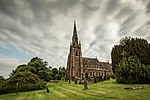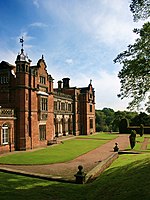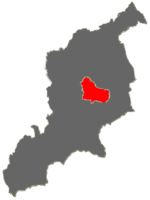Keele University School of Medicine is a medical school located in Newcastle-under-Lyme and Shrewsbury. The first two years of the school's MBChB degree are mostly taught on the Keele University campus, while early contact with patients is critical, and there is significant interaction in a clinical environment from the second year onwards.
As a constituent department of the University of Manchester, the school initially provided undergraduate medical education to clinical medical students who had finished their pre-clinical training at either the Bute Medical School at The University of St Andrew's or the School of Medical Sciences, University of Manchester. Those students were awarded the degrees of MB ChB by the University of Manchester. From 2007, Keele started to develop its own undergraduate medical curriculum and students were awarded a degree from Keele University, rather than MB ChB from Manchester as had been awarded previously.
The third year is primarily taught at the Royal Stoke University Hospital in Stoke-on-Trent and the County Hospital at Stafford (both part of the University Hospitals North Midlands Trust). The fourth and fifth years are also taught at the Royal Shrewsbury Hospital and Shrewsbury and Telford Hospital NHS Trust. Medical students are also placed in General Practice across the counties of Staffordshire, Worcestershire and Shropshire.
The medical school is ranked third in the United Kingdom by The Guardian and The Sunday Times. The school was ranked 4 out of the UK's 33 medical schools in The Sunday Times Good University Guide 2017 with a student satisfaction score of 92.4%. Within the United Kingdom the medical school is ranked second only to Oxford and ahead of Cambridge by The Guardian and The Sunday Times. Globally, the School of Medicine at Keele is ranked 9th by the QS World University Rankings (51–100), placing higher than several American Ivy League universities, including Cornell, Brown and Penn.
The school provides a learning environment that emphasises problem-based learning and small-group instruction. It also has a strong research emphasis and is home to some well-known researchers. The school also directs the National Institute for Health and Care Research School for Primary Care Research (NIHR). It also has an Impact Accelerator Unit and a Clinical Trials Unit (IAU). Keele prides itself on producing outstanding doctors and consistently ranks among the top medical schools in the UK.
The school originally accepted about 120 UK/EU and 10 non-EU medical students each year for the 5-year MBChB course and 10 UK/EU/non-EU students for the 6-year course. From 2011 the total accepted increased to about 150 from all sources. This number may vary depending on NHS requirements and funding.
Within the United Kingdom the medical school is ranked third by The Guardian and The Sunday Times . The school has an excellent reputation and is highly competitive, with an admissions rate of just over 10%.








